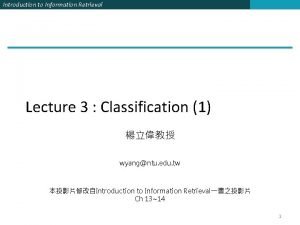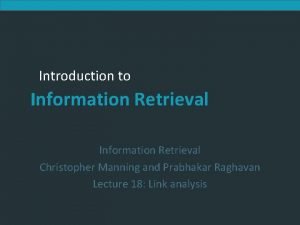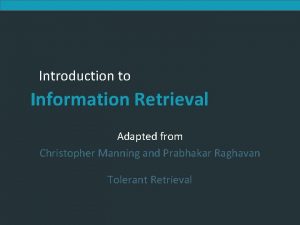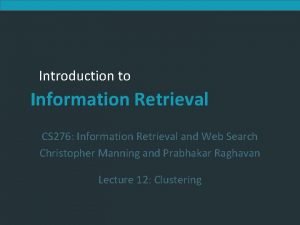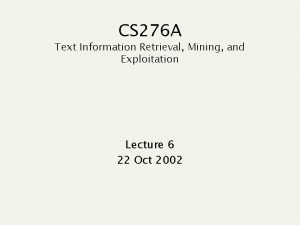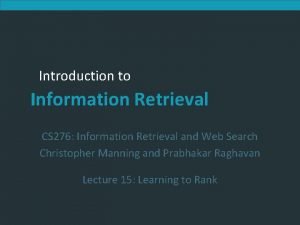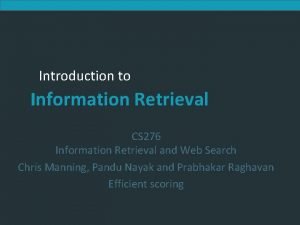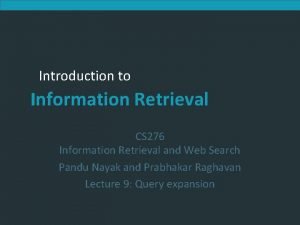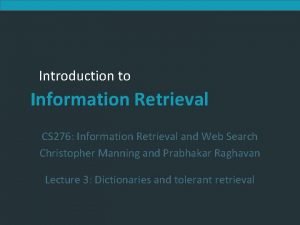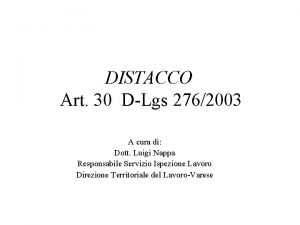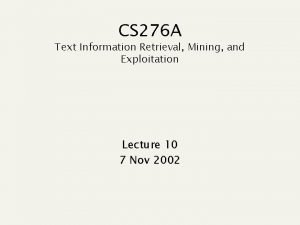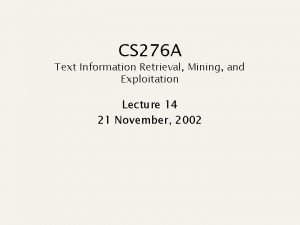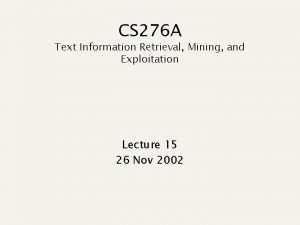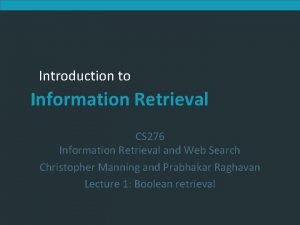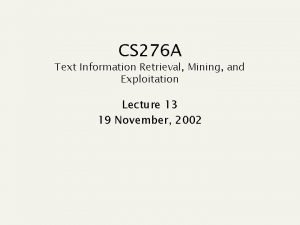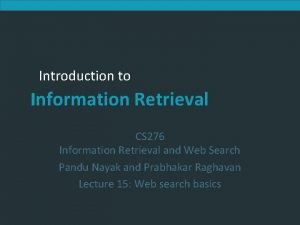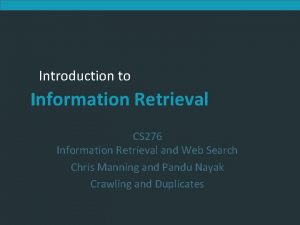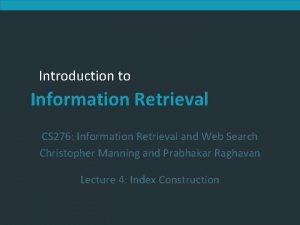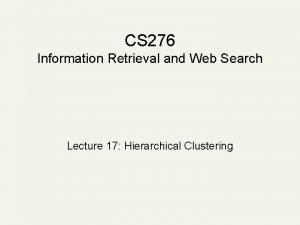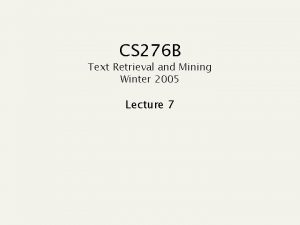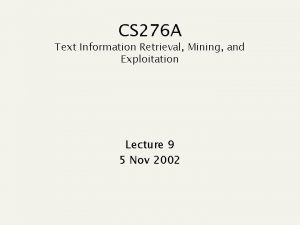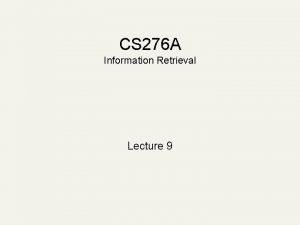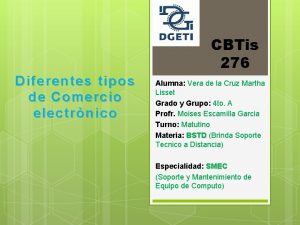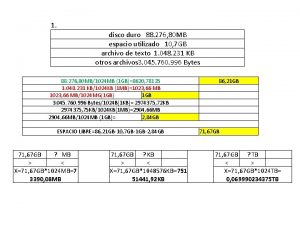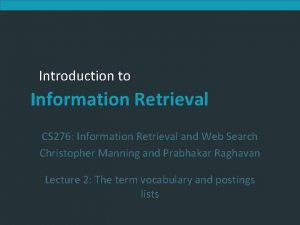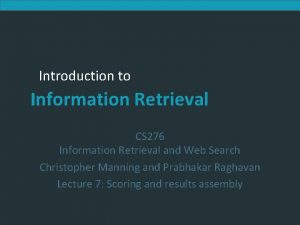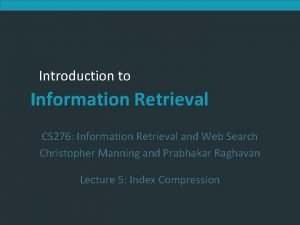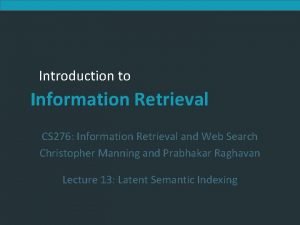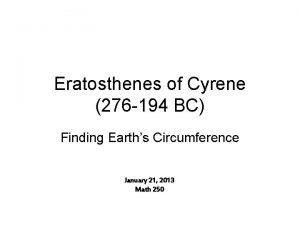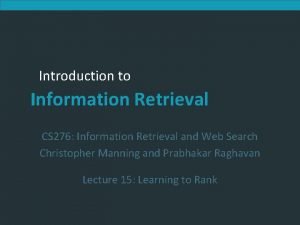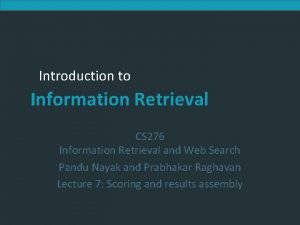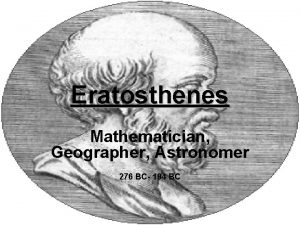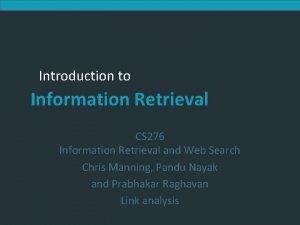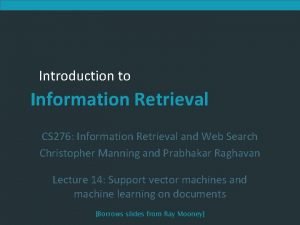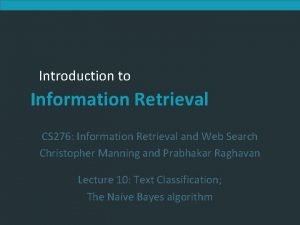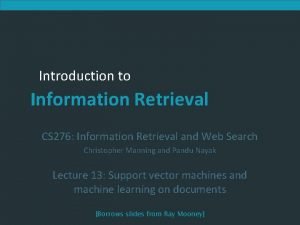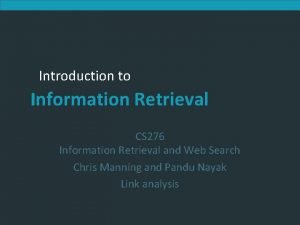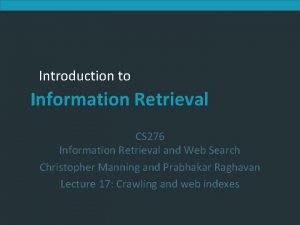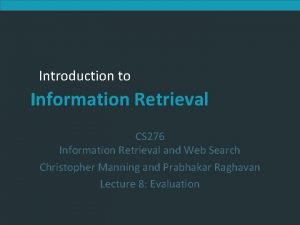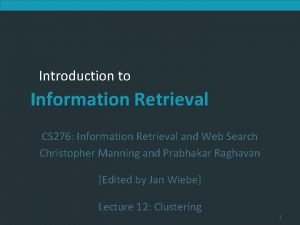Introduction to Information Retrieval CS 276 Information Retrieval








































- Slides: 40

Introduction to Information Retrieval CS 276 Information Retrieval and Web Search Chris Manning, Pandu Nayak and Prabhakar Raghavan Efficient scoring

Introduction to Information Retrieval Today’s focus § Retrieval – get docs matching query from inverted index § Scoring+ranking § Assign a score to each doc § Pick K highest scoring docs § Our emphasis today will be on doing each of these efficiently, rather than on the quality of the ranking § We’ll consider the impact of the scoring function – whether it’s simple, complicated etc. § In turn, some “efficiency tricks” will impact the ranking quality 2

Introduction to Information Retrieval Background § Score computation is a large (10 s of %) fraction of the CPU work on a query § Generally, we have a tight budget on latency (say, 250 ms) § CPU provisioning doesn’t permit exhaustively scoring every document on every query § Today we’ll look at ways of cutting CPU usage for scoring, without compromising the quality of results (much) § Basic idea: avoid scoring docs that won’t make it into the top K 3

Introduction to Information Retrieval Ch. 6 Recap: Queries as vectors § We have a weight for each term in each doc § Key idea 1: Do the same for queries: represent them as vectors in the space § Key idea 2: Rank documents according to their cosine similarity to the query in this space § Vector space scoring is § Entirely query dependent § Additive on term contributions – no conditionals etc. § Context insensitive (no interactions between query terms) § We’ll later look at scoring that’s not as simple …

Introduction to Information Retrieval TAAT vs DAAT techniques § TAAT = “Term At A Time” § Scores for all docs computed concurrently, one query term at a time § DAAT = “Document At A Time” § Total score for each doc (incl all query terms) computed, before proceeding to the next § Each has implications for how the retrieval index is structured and stored 5

Introduction to Information Retrieval Sec. 7. 1 Efficient cosine ranking § Find the K docs in the collection “nearest” to the query K largest query-doc cosines. § Efficient ranking: § Computing a single cosine efficiently. § Choosing the K largest cosine values efficiently. § Can we do this without computing all N cosines?

Introduction to Information Retrieval Safe vs non-safe ranking § The terminology “safe ranking” is used for methods that guarantee that the K docs returned are the K absolute highest scoring documents § (Not necessarily just under cosine similarity) § Is it ok to be non-safe? § If it is – then how do we ensure we don’t get too far from the safe solution? § How do we measure if we are far? 7

Introduction to Information Retrieval SAFE RANKING 8

Introduction to Information Retrieval We first focus on safe ranking § Thus when we output the top K docs, we have a proof that these are indeed the top K § Does this imply we always have to compute all N cosines? § We’ll look at pruning methods § Do we have to sort the resulting cosine scores? (No) 9

Introduction to Information Retrieval Computing the K largest cosines: selection vs. sorting Sec. 7. 1 § Typically we want to retrieve the top K docs (in the cosine ranking for the query) § not to totally order all docs in the collection § Can we pick off docs with K highest cosines? § Let J = number of docs with nonzero cosines § We seek the K best of these J

Sec. 7. 1 Introduction to Information Retrieval Use heap for selecting top K § Binary tree in which each node’s value > the values of children § Takes 2 J operations to construct, then each of K “winners” read off in 2 log J steps. § For J=1 M, K=100, this is about 10% of the cost of sorting. 1 . 9. 3 . 3. 8. 1

Introduction to Information Retrieval WAND scoring § An instance of DAAT scoring § Basic idea reminiscent of branch and bound § We maintain a running threshold score – e. g. , the Kth highest score computed so far § We prune away all docs whose cosine scores are guaranteed to be below the threshold § We compute exact cosine scores for only the un-pruned docs Broder et al. Efficient Query Evaluation using a Two-Level Retrieval Process. 12

Introduction to Information Retrieval Index structure for WAND § Postings ordered by doc. ID § Assume a special iterator on the postings of the form “go to the first doc. ID greater than X” § Typical state: we have a “finger” at some doc. ID in the postings of each query term § Each finger moves only to the right, to larger doc. IDs § Invariant – all doc. IDs lower than any finger have already been processed, meaning § These doc. IDs are either pruned away or § Their cosine scores have been computed 13

Introduction to Information Retrieval Upper bounds § At all times for each query term t, we maintain an upper bound UBt on the score contribution of any doc to the right of the finger § Max (over docs remaining in t’s postings) of wt(doc) finger t 3 7 11 17 29 38 57 79 UBt = wt(38) As finger moves right, UB drops 14

Introduction to Information Retrieval Pivoting § Query: catcher in the rye § Let’s say the current finger positions are as below Threshold = 6. 8 catcher rye in UBcatcher = 2. 3 273 UBrye = 1. 8 304 UBin = 3. 3 589 the 762 P i UBthe = 4. 3 15

Introduction to Information Retrieval Prune docs that have no hope § Terms sorted in order of finger positions § Move fingers to 589 or right Threshold = 6. 8 catcher rye in 273 UBcatcher = 2. 3 Hopeless docs 304 UBrye = 1. 8 Hopeless docs UBin = 3. 3 589 the 762 P i UBthe = 4. 3 Update UB’s 16

Introduction to Information Retrieval Compute 589’s score if need be § If 589 is present in enough postings, compute its full cosine score – else some fingers to right of 589 § Pivot again … catcher 589 rye 589 in 589 the 762 17

Introduction to Information Retrieval WAND summary § In tests, WAND leads to a 90+% reduction in score computation § Better gains on longer queries § Nothing we did was specific to cosine ranking § We need scoring to be additive by term § WAND and variants give us safe ranking § Possible to devise “careless” variants that are a bit faster but not safe (see summary in Ding+Suel 2011) § Ideas combine some of the non-safe scoring we consider next 18

Introduction to Information Retrieval NON SAFE RANKING We’ll speak of cosine scores, but most of these ideas are general and a recap of the Coursera video 19

Introduction to Information Retrieval Sec. 7. 1 Non-safe (cosine) ranking § Return K docs whose cosine similarities to the query are high § Relative to the safe top K § Reminiscent of normalization in NDCG § Can we prune more aggressively? § Yes, but may sometimes get it wrong § a doc not in the top K may creep into the list of K output docs § Is this such a bad thing?

Introduction to Information Retrieval Sec. 7. 1. 1 Cosine similarity is only a proxy User has a task and a query formulation Cosine matches docs to query Thus cosine is anyway a proxy for user happiness If we get a list of K docs “close” to the top K by cosine measure, should be ok § All this is true for just about any scoring function § §

Introduction to Information Retrieval Sec. 7. 1. 1 Generic approach § Find a set A of contenders, with K < |A| << N § A does not necessarily contain the top K, but has many docs from among the top K § Return the top K docs in A § Think of A as pruning non-contenders § Unlike WAND, pruning here can be lossy § The same approach is also used for other (noncosine) scoring functions § Will look at several schemes following this approach § Often A may not be explicitly spelled out a priori

Introduction to Information Retrieval Sec. 7. 1. 2 Index elimination § Basic cosine computation algorithm only considers docs containing at least one query term § Take this further: § Only consider high-idf query terms § Only consider docs containing many query terms

Introduction to Information Retrieval Sec. 7. 1. 2 High-idf query terms only § For a query such as catcher in the rye § Only accumulate scores from catcher and rye § Intuition: in and the contribute little to the scores and so don’t alter rank-ordering much § Benefit: § Postings of low-idf terms have many docs these (many) docs get eliminated from set A of contenders

Introduction to Information Retrieval Sec. 7. 1. 2 Docs containing many query terms (DAAT) § Any doc with at least one query term is a candidate for the top K output list § For multi-term queries, only compute scores for docs containing several of the query terms § Say, at least 3 out of 4 § Imposes a “soft conjunction” on queries seen on web search engines (early Google) § Easy to implement in postings traversal

Introduction to Information Retrieval Sec. 7. 1. 3 Champion lists § Precompute for each dictionary term t, the r docs of highest weight in t’s postings § Call this the champion list for t § (aka fancy list or top docs for t) § Note that r has to be chosen at index build time § Thus, it’s possible that r < K § At query time, only compute scores for docs in the champion list of some query term § Pick the K top-scoring docs from amongst these

Introduction to Information Retrieval Sec. 7. 1. 4 High and low lists § For each term, we maintain two postings lists called high and low § Think of high as the champion list § When traversing postings on a query, only traverse high lists first § If we get more than K docs, select the top K and stop § Else proceed to get docs from the low lists § A means for segmenting index into two tiers

Introduction to Information Retrieval Sec. 7. 2. 1 Tiered indexes § Break postings up into a hierarchy of lists § Most important § … § Least important § Inverted index thus broken up into tiers of decreasing importance § At query time use top tier unless it fails to yield K docs § If so drop to lower tiers § Common practice in web search engines

Introduction to Information Retrieval Example tiered index Sec. 7. 2. 1

Introduction to Information Retrieval RECAP OF SOME FINAL SCORING IDEAS 30

Introduction to Information Retrieval Document dependent scoring § Sometimes we’ll have scoring functions that don’t add up term-wise scores § We’ll look at two instances here, but industry practice is rife with these § Static document goodness measures § Term proximity 31

Introduction to Information Retrieval Sec. 7. 1. 4 Static quality scores § We want top-ranking documents to be both relevant and authoritative § Relevance is being modeled by cosine scores § Authority is typically a query-independent property of a document § Examples of authority signals § § § Wikipedia among websites Articles in certain newspapers A paper with many citations Many bitly’s, likes or social referrals marks (Pagerank) Quantitative

Introduction to Information Retrieval Sec. 7. 1. 4 Modeling authority § Assign to each document a query-independent quality score in [0, 1] to each document d § Denote this by g(d) § Thus, a quantity like the number of citations is scaled into [0, 1]

Introduction to Information Retrieval Net score § Consider a simple total score combining cosine relevance and authority § net-score(q, d) = g(d) + cosine(q, d) § Can use some other linear combination § Indeed, any function of the two “signals” of user happiness – more later § Now we seek the top K docs by net score Sec. 7. 1. 4

Introduction to Information Retrieval Top K by net score – fast methods § First idea: Order all postings by g(d) § Key: this is a common ordering for all postings § Thus, can concurrently traverse query terms’ postings for § Postings intersection § Cosine (or other) score computation Sec. 7. 1. 4

Introduction to Information Retrieval Sec. 7. 1. 4 Why order postings by g(d)? § Under g(d)-ordering, top-scoring docs likely to appear early in postings traversal § In time-bound applications (say, we have to return whatever search results we can in 50 ms), this allows us to stop postings traversal early § Short of computing scores for all docs in postings

Introduction to Information Retrieval Sec. 7. 1. 4 Champion lists in g(d)-ordering § Can combine champion lists with g(d)-ordering § Maintain for each term a champion list of the r docs with highest g(d) + tf-idftd § Seek top-K results from only the docs in these champion lists § Combine with other heuristics we’ve seen …

Introduction to Information Retrieval Sec. 7. 2. 2 Different idea – Query term proximity § Free text queries: just a set of terms typed into the query box – common on the web § Users prefer docs in which query terms occur within close proximity of each other § Let w be the smallest window in a doc containing all query terms, e. g. , § For the query strained mercy the smallest window in the doc The quality of mercy is not strained is 4 (words) § Would like scoring function to take this into account – how?

Introduction to Information Retrieval Scoring factors § The ideas we’ve seen are far from exhaustive § But they give some of the principal components in a typical scoring function § They reflect some intuition of how users phrase queries, and what they expect in return § Scoring goes beyond adding up numbers § E. g. , if we get too few hits – how should we increase recall on the fly? § If it’s an obvious “nav query” how do we cut recall? 39

Introduction to Information Retrieval Sec. 7. 2. 3 Non-additive scoring § Free text query from user may in fact spawn one or more queries to the indexes, e. g. , query rising interest rates § Run the query as a phrase query § If <K docs contain the phrase rising interest rates, run the two phrase queries rising interest and interest rates § If we still have <K docs, run the vector space query rising interest rates § Rank matching docs by vector space scoring § This sequence is issued by a query handler
 Manning introduction to information retrieval
Manning introduction to information retrieval Bvf document
Bvf document Introduction to information retrieval
Introduction to information retrieval Introduction to information retrieval manning
Introduction to information retrieval manning Cs 276
Cs 276 Cs 276
Cs 276 Relevance information retrieval
Relevance information retrieval Cs 276
Cs 276 Cs 276
Cs 276 Relevance information retrieval
Relevance information retrieval Fleas editing dictionary code
Fleas editing dictionary code Art 30 276 del 2003
Art 30 276 del 2003 Cs 276
Cs 276 Cs-276
Cs-276 Cs-276
Cs-276 Cs276 stanford
Cs276 stanford Cs 276
Cs 276 Psalm 276
Psalm 276 Item 356
Item 356 Cs 276
Cs 276 Cs 276
Cs 276 Cs 276
Cs 276 Cs 276
Cs 276 Cs 276
Cs 276 Cs 276
Cs 276 Cs 276
Cs 276 Cs 276
Cs 276 Cs 276
Cs 276 Cbtis 276
Cbtis 276 276 + 80
276 + 80 Ncbr limit 276 godzin
Ncbr limit 276 godzin Esercizi alternatore
Esercizi alternatore Cs 276
Cs 276 Cs 276
Cs 276 Cs 276
Cs 276 Cs 276
Cs 276 276-194
276-194 Cs 276
Cs 276 Cs 276
Cs 276 Cs 276 stanford
Cs 276 stanford 276 bc
276 bc

